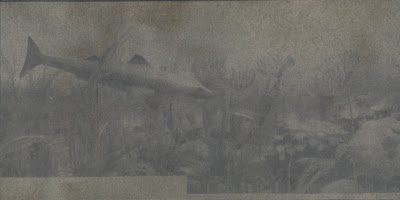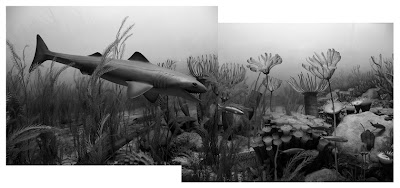
I had to share this horrible print. It’s a good example of how happy accidents and a willingness to experiment can lead to interesting results. In this case, It’s also an example of how easy it is to go too far when experimenting and ruin a piece.
The negative for this print was made as an afterthought. I was making a 13 X 13 inch negative of an image I shot with my Holga camera (which turned out good-I’ll post it in a couple of days). I was using a 13 X 19 sheet of Pictorico transparency, and couldn’t bring myself to waste the 6 X 13 bit left over. So, I threw together this image, made from two photos I took at the University of Michigan’s Exhibit Museum last summer. Here’s the grayscale version used to print the negative:

I was planning to make a cyanotype print, in fact the negative was printed with the cyanotype transfer curve I created last Fall. However, at the same time I was cutting paper for this print, I was also cutting several pieces to make gum prints with. My first mistake was shrinking and sizing the the paper for this print along with the paper for the gum prints. Preshrinking and sizing are necessary for gum prints, but not for cyanotypes. No big deal, I can still do a cyanotype on paper that has been sized with gesso. But, it changed the exposure, and the resulting cyanotype was too light.
Still no big deal, I’ve been experimenting with making gum prints using metallic acrylic paint, and thought the underexposed cyanotype would be interesting with a gum layer made from the copper colored metallic paint I just bought. Unfortunately, I guessed at the paint to gum ratio and exposure time (It worked for the gold metallic paint-see my last post) and what I got was a solid copper colored print with no details. While soaking the print (gum prints develop by soaking in s tray of still water), I decided to add a splash of ammonia (ammonia is used to reduce density in an overexposed gum layer). It didn’t do anything for the copper layer, but I could see that something was happening. Then I remembered: Ammonia bleaches cyanotype prints, it’s one of the methods used to tone a cyanotype print. Sure enough, I now had a bleached cyanotype covered with a solid opaque layer of metallic copper acrylic.
I needed to get rid of the copper, and ammonia wasn’t cutting it. So I took a wet cotton ball and rubbed the entire copper layer off (wet layers on gum prints are really soft and easily manipulated).I was left with a bleached out cyanotype with a bit of copper colored stain. I threw this print into a tray, and grabbed a bottle of tannic acid I mixed a couple of months ago when making a bunch of toned cyanotypes (tannic acid is used in a lot of cyanotype toning formulas). Unfortunately, tannic acid is susceptible to mold, which I discovered when I poured it in the tray and saw huge globs of mold landing on the surface of the print. FIguring the print was ruined anyway, I dumped the entire bottle of moldy tannic acid on it and left it to soak while making a couple more gum prints.
Surprisingly, the results were pretty nice. The cyanotype had turned a light purple-gray color. It ws still underexposed, but the color was really nice, one of the nicer toned cyanotypes I‘ve done. I could have stopped there, but the cyanotype was too light, and I had some silver metallic paint I wanted to try gum printing with. Yesterday, I attempted a silver gum layer, and got the result you see above. While the print was soaking to develop the silver gum layer, I could see the back of the print discoloring, so I knew something was up. I’m not sure what went wrong. I made another silver gum print at the same time that doesn’t have the odd staining. If I had to guess, I’d say that the tannic acid hadn’t been washed out of the paper fully, and that it reacted with the gum sensitizer to give me that ugly, stained print. I tried removing the silver layer with a wet cotton ball, but it didn’t budge.
It was a fun experiment, and I do think that a silver or copper gum layer would look good over a cyanotype. For now, I think I’ll just do a plain cyanotype of this image and see how I like it.



